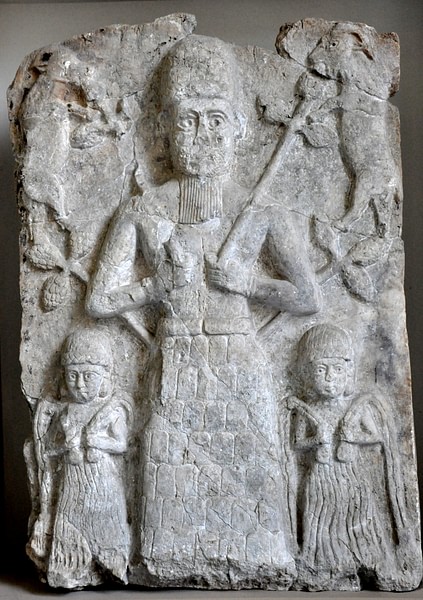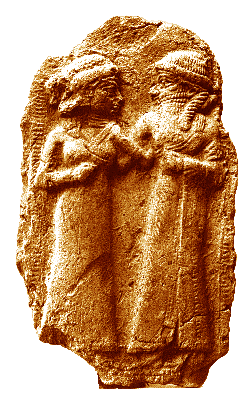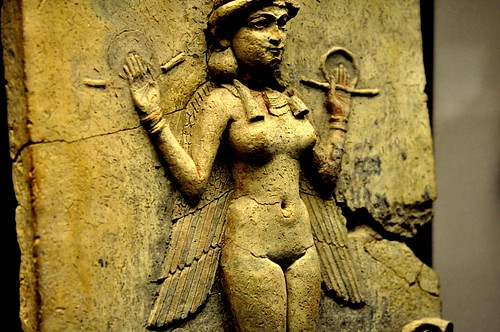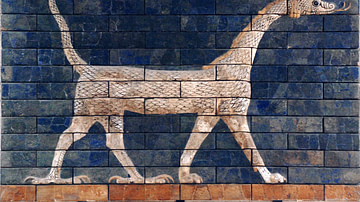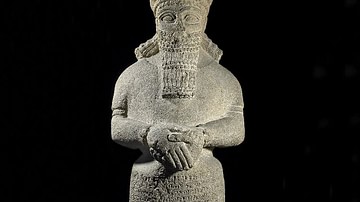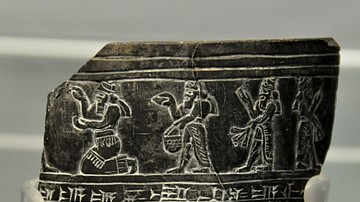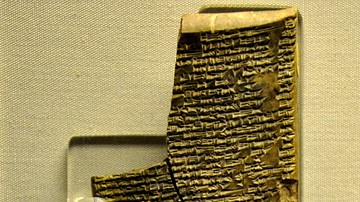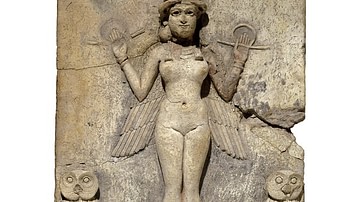The gods of the Mesopotamian region were not uniform in name, power, provenance or status in the hierarchy. Mesopotamian culture varied from region to region and, because of this, Marduk should not be regarded as King of the Gods in the same way Zeus ruled in Greece. While Marduk was venerated highly in Babylon, Enlil held that place in Sumer.
It should also be noted that the English word 'demon', understood as an evil spirit, derives from the Greek word 'daimon' which meant, simply, 'spirit' and that many of the supernatural entities of the Mesopotamian pantheon designated as 'demons' were not necessarily evil.
The following is a list of the gods of the Mesopotamian Pantheon but, as the Mesopotamian people worshipped between 300 and 1000 different gods, it is by no means a complete listing. Thorkild Jacobsen, in his work The Treasures of Darkness: A History of Mesopotamian Religion, states, "The gods who formed the assembly of the gods were legion. It is not possible to characterize more than a few prominent ones." Even so, the following list makes the attempt at being as comprehensive as possible and is based on the primary documents of the myths, stories and poems of Mesopotamia and, in part, on the works of Jeremy A. Black, et.al., Stephanie Dalley, Will Durant, Thorkild Jacobsen, Samuel Noah Kramer and Gwendolyn Leick. Non-deities who feature prominently in famous works (such as Etana) are included in the list sparingly.
THE MESOPOTAMIAN GODS
ABGAL - The seven sages in Sumerian mythology sent to the earth by Enki at the beginning of time to give human beings the sacred `me' (laws) of civilization. They were also known, by the Akkadians and Babylonians, as The Apkallu or the Apkallu Fish and are depicted with the body of a fish and the head of a man or with the torso of a fish and human arms, legs and head, sometimes with and sometimes without wings. In the Babylonian tradition, the Apkallu also appear as Griffins or simply as humans with wings. The Abgal carry a bucket and a cone of incense for purification purposes. By name, they were Adapa (the first man) Uan-dugga, En-me-duga, En-me-galanna, En-me-buluga, An-enlilda and Utu-abzu.
ABSU - The Babylonian, Akkadian and Sumerian god of fresh water and the sweet waters of the world. Also known as Apsu and Abzu, he encircled the earth and merged his fresh waters with the salt waters of his consort, Tiamat; from their union all the other gods were born. He was killed by his son, Ea, which provoked the war of the gods with Tiamat. The story of Absu is told in the Enuma Elish. He is depicted as more ethereal than physical.
ADAD - The Babylonian god of storms, a darker version of the Sumerian god Ninurta. Known to the Sumerians as Ishkur, he is depicted with a lion-headed dragon or a bull and carrying a hammer or lightning bolt. His consort was the goddess Shala.
ADAPA - In Sumerian and Babylonian mythology, the first created man, son of Ea (or Enki) who, in anger at the overturning of his boat, broke the wings of the South Wind and had to travel to the heavens to apologize to Anu. Ea, knowing that Anu would offer Adapa the food of immortality and wishing human beings to remain mortal, warned the man not to eat or drink of anything while in the land of the gods as doing so would surely kill him. Adapa heeds Ea's advice and refuses the food and drink offered to him and, so, is tricked out of the chance at immortality. He was the first among the Abgal, the seven ancient sages.
ADRAMELECH - The Babylonian sun god and personification of the sun, giver and sustainer of life. His consort was Anamelech, moon goddess and the moon. He is portrayed negatively in The Bible (II Kings 17:31) as demanding child sacrifice and is depicted in Milton's Paradise Lost as an evil demon.
AJA - The Akkadian goddess of the dawn, consort to Shamash. She was associated with youth, sexual love and marriage and was referred to as `The Bride'. Aja (also known as Aya) developed from the more ancient and very popular Sherida of the Sumerians.
APKALLU GRIFFIN - The Babylonian version of the Abgal.
APSU - The same god as Absu/Abzu.
AMURRU - The Akkadian and Sumerian name for the storm/sky god of the Amorite people (also known as the Amurru) who migrated to the Mesopotamian region c. 2100 BCE. The god Amurru is associated with Adad but is a gentler version always depicted with a gazelle and a shepherd's crook or staff and watched over nomads. He was also known as Martu. His consort is Beletseri, scribe of the dead.
ANSHAR - The Babylonian god of the sky from `An' translated as `heaven' and `shar' for `complete' or `entire', so God of the Whole Sky. Differs from Anu in that he is only the god of the sky not the heavens above the clouds. Also one of the sons of the primordial gods Apsu and Tiamat, consort of Kishar. Anshar and Kishar symbolized heaven and earth, respectively.
ANTUM - The Babylonian goddess of the earth, an early fertility goddess.
ANU - Also known as An in the Sumerian pantheon, he was the sky god and Lord of the Heavens in tales written before 2500 BCE. His consort was Antu and, from their union, were born the Annunaki, the judges of the dead. The Sumerian word `An' is translated as`heaven' and he was associated with thunder rolling across the skies. During storms he was imagined as a great bull roaring above the clouds. Anu became, in time, the supreme lord who was the power behind that of all the other deities. Only his son Enlil had access to him and people would pray to the lesser gods who would pass their request up the chain to Enlil. Anu is the first to hold the Tablets of Destiny before passing them on to Enlil.
ANUNNAKI - The Mesopotamian `fates' and judges of the dead born of the union between Anu and Antu. In Babylonian mythologies they were considered spirits of the earth but still were depicted in the role of judges or `those who see'.
ANZU - The divine sky creature depicted as a giant bird with the head of a lion, also known as Zu and Imdugud, and featured in tales from the Babylonians, Sumerians and Akkadians. The Anzu bird appears prominently in the Sumerian tale of The Huluppu Tree where he is one of the creatures infesting the tree of Inanna. In another myth he is charged with guarding the Tablets of Destiny which legitimized the rule of the supreme god but, instead, stole them. The god Ninurta retrieves the Tablets and kills Anzu (in other versions of the story Marduk is featured as the hero). Anzu was said to breathe fire and was so enormous that the flapping of his wings brought on huge storms.
ARAZU - The Babylonian god of completed construction. He was worshipped at the conclusion of building projects.
ARURU - The Babylonian goddess of nature, an early mother goddess who created human beings in consort with Enki (sometimes Enlil).
ASHNAN - The Sumerian goddess of grain. Ashnan and her sister, Lahar, were the children of Enlil, born to provide sustenance to the Annunaki, the judges of the dead. It was found, however, that the Annunaki could eat none of it and so human beings were created to eat of the grains instead so that the efforts of Ashnan and Lahar would not be wasted.
ASSUR - Also known as Ashur and, in Akkadian, Anshar. The supreme god of the Assyrians who originated as a local deity of the city of Ashur. He was the Assyrian god of the sky and of war known as The Lord of the Whole Heavens. His name (Anshar) means `whole heaven' in Akkadian and he was invoked often as a powerful ally by Assyrian kings (whose names often contain elements of his, as in Ashurbanipal). He is often depicted as a feather-robed archer drawing a bow riding on a serpent or dragon. Much of his mythology and iconography (such as the serpent-dragon of Marduk or his wife Ninlil) are borrowed from Sumerian or Babylonian works.
BABA - Also known as Bau or Bawa, she was the Sumerian goddess of Lagash, a local mother goddess and fertility goddess known as `Mistress of Animals' and `Lady of Abundance'.
BABBAR - Another name for Utu/Shamash, the sun god, meaning "illumination" or "The Illuminating One".
BASMU - The Mesopotamian great serpent associated, alternately, with birth and birth goddesses or with Ningishzida, a god of the underworld. In his association with birth, Basmu is sometimes pictured horned while, as the symbol of Ningishzida, he is entwined around a staff or pictured as two copulating snakes.
BEL - The Babylonian god of sages. Associated with Marduk, sometimes depicted as his brother, Bel was very clever and wise. He was the son of Enki (Ea), the god of wisdom.
BELIT-TSERI - The Babylonian scribe of the underworld, she kneels by the throne of Ereshkigal and records the names of the dead as they enter the dark realm. She was referred to as the `Queen of the Desert'. Her consort was Amurru, Amorite god of the sky and of nomads.
BIRDU - The Babylonian messenger god from the underworld.
BULL OF HEAVEN - Also known as Gugalanna, the Bull of Heaven was consort to the Queen of the Underworld, Ereshkigal, and was controlled by the Lord of the Sky, Anu. In The Epic of Gilgamesh, Ishtar, spurned by Gilgamesh, demands that Anu release the Bull of Heaven to wreak havoc on Gilgamesh's kingdom in retribution. The Bull of Heaven is killed by Gilgamesh and Enkidu and, for this act, it is decreed that Enkidu must die. In the poem The Descent of Inanna, the sky goddess goes down into the underworld to pay her respects to her sister, Ereshkigal, after the death of her consort.
BULL-MAN - In Sumerian mythology, a demon who works closely with human beings and the gods to hold at bay the forces of chaos. He is depicted as a man above the waist and a bull below.
CARA - The Sumerian god known as Inanna's Beautician. He is one of those whom the underworld demons try to carry off as a substitute for Inanna in the afterlife after she returns to earth in the poem The Descent of Inanna. He is spared because Inanna tells the demons that Cara is essential to her.
DAGON - Also known as Dagan, he was the Babylonian god of grain and fertility who was especially popular in the mid-Euphrates region of Mesopotamia where he also controlled the weather. His qualities were eventually assumed by Adad.
DAMU - The Sumerian god of healing, son of Gula, goddess of healing. Damu was considered the intermediary between his mother and mortal doctors.
DAMKINA The Babylonian consort to the god Ea, mother of the hero-god Marduk.
DILMUN - In Sumerian mythology, the site of creation, paradise, where Utnapishtim is transported to with his wife after the great flood.
DUMUZI - The Sumerian god of fertility and shepherds who was husband to the goddess Inanna and brother of Geshtinanna. He takes Inanna's place in the underworld after she is trapped and killed there by Ereshkigal and Geshtinanna then offers to take his place. He remains in the underworld for half the year and Geshtinanna the other half, thus explaining the cycle of the seasons.
EA/ENKI - The Babylonian god of wisdom and fresh waters, known in Sumeria as Enki and introduced, or at least further developed by, the Akkadians. He was the god of magic who defeated his father Apsu and created the earth. Ea/Enki was one of the most important and beloved gods in the Mesopotamian pantheon and features prominently in the story of the Great Flood where he saves humankind by advising the good man Atrahasis to build an ark before the waters come and, in the famous Descent of Inanna, provides the means to rescue the goddess from the underworld. He was the wisest among the gods and the patron of craftsmen, artisans and exorcists. In the story Inanna and the God of Wisdom he allows himself to become drunk and gives away the meh, the gifts of civilization and property of the gods, to Inanna knowing she will disperse them to humanity. He is uniformly depicted as a friend of human beings and their advocate among the gods.
ELLIL - The Babylonian name of Enlil, god of the wind and storms and the King of the Gods before he is replaced by Marduk.
EMESH - The Sumerian god of summer and personification of summer. He created the trees and fertile fields and was the brother of Enten, the god of winter. Emesh was depicted as a farmer.
ENBILULU - The Mesopotamian water god charged with the care of the Tigris and Euphrates rivers.
ENKIMDU - The Mesopotamian god of canals and ditches and, like Emesh, was depicted as a farmer with plow and yoke. He was also the god of farmers, the fields and grain.
ENKI - see EA.
ENKIDU - The Sumerian god of the forests and the wild. Created by the gods and sent to earth to teach the proud King Gilgamesh a lesson in humility, Enkidu became Gilgamesh's best friend and brother. His death, following the slaying of the Bull of Heaven, is the impetus for Gilgamesh to embark on his quest for the meaning of life.
ENLIL - The Sumerian god of the air whose name means `Lord of the Air and Wind' but far more powerful than any mere elemental deity. His consort was Ninlil. Enlil, Anu, and Enki made up a triad which ruled Heaven, Earth, and the Underworld or, alternately, the heavens, sky and atmosphere, and earth. Enlil was an important weather god often prayed to and worshipped in hopes of fair weather for a good harvest. Holder of The Tablets of Destiny, he was the Lord of the Sumerian pantheon after 2500 BCE and worshipped by the Akkadians c. 2334-c. 2083 BCE. He was later absorbed into the god Marduk during the reign of Hammurabi (1792-1750 BCE). Enlil is featured in a number of myths as a supreme deity and king of the gods. Although his cult center was at Nippur, he was widely venerated throughout Mesopotamia.
ENMESSARA - A Sumerian god of the underworld.
ENTEN - The Sumerian god of winter who watched over the birth and health of animals during the cold, rainy season. His brother was Enmesh, the god of summer.
ERESHKIGAL - The Sumerian goddess of the underworld and Queen of the Dead whose name means `Lady of the Great Place'. Ereshkigal was an important and much feared goddess whose consort was the Bull of Heaven until he was killed by Enkidu. She was the older sister of the goddess Inanna whom she blamed for the Bull of Heaven's death and whom she killed when Inanna came to visit her in the underworld for his funeral. Owing to the cleverness of Enki she is forced to surrender Inanna back to the land of the living. She rules the land of the dead alone (known to the Mesopotamians generally as `The Land of No Return', a dark and gloomy place) until the coming of the god Nergal who becomes her consort. She was also known as Irkalla. Tales concerning Ereshkigal, like The Marriage of Ereshkigal and Nergal or The Descent of Inanna bear similarities to the later Egyptian myth of Osiris and Isis and the Greek myth of Demeter and Persephone in the motif of the Dying and Reviving God best known from the story of Jesus Christ.
ERRAGAL - A Sumerian god of the underworld.
ERIDAN - The river which ran through the underworld. Healthy and strong spirits of the dead could drink from the river but weak spirits had to drink stale water from puddles and eat dust.
ERRA - The Babylonian god of war, destruction, death and strife, also known as Nergal. Best known from the work The Wrath of Erra in which he destroys Babylon for no reason after tricking Marduk into leaving the city. See IRRA.
ESEMTU - The corpse of a human being, the mortal remains which had to be cared for and buried in order for the soul of the dead to thrive in the underworld.
ETANA - The hero of the Sumerian Epic of Etana which tells the story of King Etana, one of the early antediluvian rulers, who, despairing of having a son because his wife is barren, ascends to the heavens on the back of the great eagle he aided to present his case before the gods. He is given the plant of birth, which he and his wife must eat together, and is rewarded with a son, Balih.
ETEMMU - The immaterial spirit released from the human being at death, not to be confused with the soul. The etemmu was the animating spirit breathed into the first humans created from the remains of the god Quingu after his death. The flesh of Quingu was mixed with clay and blood but animated through etemmu, a spirit of transience, so that, though created from an immortal god, human beings would still die.
GALLA - The Sumerian demons of the underworld who drag humans down to the realm of Ereshkigal. The Galla are featured in the Hymn to Igalima and in The Descent of Inanna where they are sent by Enki to help Inanna and also drag Dumuzi to the underworld.
GARRA - The Babylonian god of fire, especially noted for cleansing or purifying fire. Also known as Gerra.
GESHTINANNA - The Sumerian goddess of fertility and sister to Dumuzi whose name means `The Vine of Heaven'. She was in charge of the fertility of the earth from the spring to the fall equinox when she would then go down to the underworld to release Dumuzi (who had taken Inanna's place) and he, then, would return to the earth to oversee fertility for the next six months of the year.
GESHTU - Also known as Geshtu-e, We-llu, he was the god who offered his blood and intellect for use in the creation of human beings in the Akkadian/Babylonian myth The Atrahasis.
GIBIL - The Assyrian god who presided as judge over gods and men, known as the Governor of the Gods. He was associated with judges and took a keen interest in punishing those who had been unjust judges in life. Also the name of a fire god.
GILGAMESH - The Sumerian hero of The Epic of Gilgamesh who appears as a mortal in the Sumerian King List as King of Uruk but who, in myth, is depicted as a god or, at least, a demi-god. In the poem The Huluppu Tree he is brother to the goddess Inanna while in The Epic of Gilgamesh he is propositioned by Inanna (as Ishtar) and rebuffs her, causing her to send the Bull of Heaven to earth as punishment which results in the death of Gilgamesh's best friend and brother, Enkidu. Enkidu's death then inspires Gilgamesh to embark on his quest for the meaning of life and immortality.
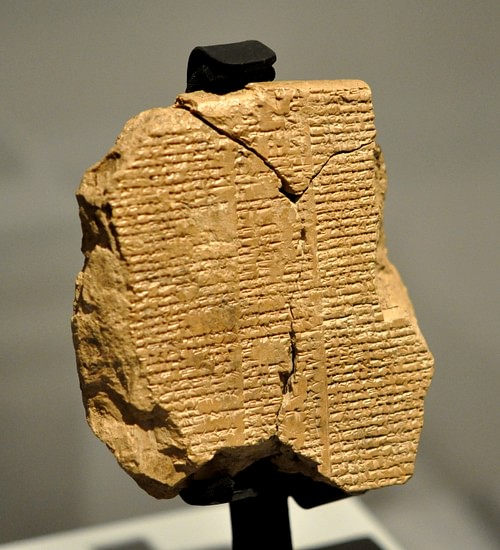
GISHIDA – The Babylonian god of the Tree of Life and early spring. He is a dying and reviving god who, with Tammuz, stand guard at the gates of heaven in the Myth of Adapa. The god Ea tells Adapa to acknowledge the `disappearance of two gods from the land' by way of paying respect to Gishida and Tammuz, both of whom leave the earth for part of the year (thus explaining the change in seasons). Also known as Ningishzida (See NINGISHZIDA).
GUGALANNA - The Sumerian Bull of Heaven and first husband to the goddess Ereshkigal. See BULL OF HEAVEN.
GULA - Also known as Ninkarrak, Ninisina and originally Bau, a dog goddess. Gula was the Sumerian goddess of healing, consort of Ninurta, Pabilsag, and Abu and so also associated with agriculture and growth. She was the patroness of doctors and the healing arts and is usually depicted surrounded by stars with her dog by her side. She is associated with the underworld and transformation. Mother of Damu, Ninazu, and Gunurra, all healing deities also linked with transformation/transition.
GUSHKIN-BANDA - The Babylonian creator of man and gods who was depicted as a craftsman, most often a goldsmith.
HAIA - The Sumerian god of storehouses and goods. He was best known as the father of the goddess of grain, Ninlil, whose rape by Enlil formed the basis of the famous fertility myth.
HUMBABA - The Sumerian daimon and guardian of the great Cedar Forest who is killed by Gilgamesh and Enkidu in The Epic of Gilgamesh. He is depicted as a hairy giant with lion's claws and a monster's face.
IGIGI - The Babylonian god of the heavens, the region above the clouds, also the collective name for the gods who dwelt above the clouds.
IMDUGUD - The Sumerian version of Anzu, Pazusu and Zu who had a tendency to whip rainstorms into whirlwinds by flapping his wings. He was especially venerated in the region around the City of Ur.
INANNA - (known to the Assyrians as Ishtar) - The Sumerian goddess of sexuality, passion, fertility, love, prostitutes and war. Inanna became closely identified with the Babylonian goddess Ishtar who, in time, assumed many of her attributes. The most popular and beloved of all the Sumerian pantheon, Inanna features prominently in many of the best known and frequently copied stories, myths and hymns of Sumer (among them, The Descent of Inanna, Inanna and the God of Wisdom, The Courtship of Inanna and Dumuzi, and The Huluppu Tree) and is listed among the seven primary deities of Sumer early on along with Anu, Enlil, Enki, Ninhursag, Nanna, and Utu. Sargon of Akkad (Sargon the Great) invoked Inanna for protection and victory in battle and for guidance in politics and his daughter, Enheduanna, was the Chief Priestess of Inanna at Uruk and the composer of many hymns and songs to her. She is often depicted riding on a lion and referred to as `The Queen of Heaven'. Her older sister was Ereshkigal. She was the foremost goddess and patron of the city of Uruk to whom she was said to have given the sacred `me' (laws) which were given her in a drunken revel by the god of wisdom, Enki. Many of the compositions concerning her depict her as highly sexual, unmarried, and able to "turn men into women" with passion. She was associated with the planet Venus. In the Myth of Etana she is referenced as Innina and, early on, was considered the twin sister of Utu (Shamash) the sun god.
IRKALLA - See ERESHKIGAL
IRRA - Also known as Erra, the Babylonian god of plagues pestilence, death, war, and destruction, associated with Nergal, god of death. Irra was a clever and annoying demon responsible for all kinds of human miseries. In The Epic of Irra (also known as The Wrath of Erra) he takes over the city of Babylon in Marduk's absence, leading to its destruction or, alternately, delivers Babylon from her enemies but only after `turning the world upside down' with the slaughter of the righteous and unrighteous alike. The Epic of Irra text was enormously popular in Babylon. More copies of this work have been discovered than copies of the more famous Epic of Gilgamesh.
ISHARA - (Also Isara) - The Mesopotamian goddess of the oath known as `Queen of Judgment', she was also associated with love, war, and divination and also sometimes appears as a mother goddess or an underworld deity. According to scholar Jeremy Black she was "more closely connected with the Semitic tradition than the Sumerian" (110) and was assimilated into Inanna. She was associated with the god Dagan.
ISHKUR - (Also known as Iskur, Adad, Addu) - The Sumerian god of weather and storms, twin brother of Enki in some myths.
ISHTAR - The Babylonian version of the Sumerian goddess Inanna only more sexualized. In The Epic of Gilgamesh she tries to seduce King Gilgamesh, is repulsed by him as he lists her many faults as a fair-weather lover, and calls down the Bull of Heaven to punish the king. See INANNA.
ISHUM - The Babylonian god of fire.
KABTA - The Sumerian god of pickaxes, construction and bricks, brother of Mushdamma (god of foundations and buildings) and one of the many sons of Ninhursag.
KI - See NINHURSAG
KISHAR - The Babylonian goddess of the earth and fertility. As her name, `Ki' and `Shar' means `the entire earth', she is considered a mother goddess responsible for growth below and above the ground. She is the mother of Anu in some myths and associated with Anshar (heaven).
KITTU - The Sumerian god of justice, brother of Misharu. In some sources Misharu is the god of law and Kittu the god of justice which proceeds from the law, in others they appear equal as both being gods of law and justice. See MISHARU.
KULITTA - The Babylonian goddess of music who served Ishtar with beautiful songs for Tammuz.
KULLA - The Babylonian god who restored temples, also known as the brick god who, like Kabta and Mushdamma, was invoked in the laying of the foundation of buildings and praised or sent away upon completion. Tablets from the Akkadian period provide incantations for blessings from Kulla at the inception of a project as well as banishing the god from the site once the building was done as it was thought he might otherwise stay around when there were others in need of him and, further, that his presence could mean further building was required.
KULULLU - The collective name for water spirits, elemental spirits of streams and lakes, in Assyrian mythology.
KUSAG - The Babylonian god of the priesthood, patron god of priests. Kusag is the High Priest among the gods and officiates at their rites.
KUR - The Sumerian word for `mountain' which referred to either the high abode of the gods or the vast expanse of the underworld beneath the earth's surface, depending on the context.
LAHAR - The Sumerian goddess of cattle. She and her sister, Anshar, were originally created to feed and adorn the Anunnaki. See ANSHAR.
LAHMU and LAHAMU - Two early Babylonian gods, the first born of Absu and Tiamat, from whom all the other gods were born.
LAMA - The Sumerian goddess of protection. She was known to the Akkadians as Lamassu. As Lama she was depicted as a woman in a long, tiered robe while, as Lamassu, she appeared as a winged bull or lion with a woman's face or head and protected temples and palaces against the forces of chaos and their attendant evils. Lama appears often on cylinder seals and was widely petitioned for intercession with the gods. Her name means `protective spirit'.
LAMASHTU - A Babylonian demoness who was particularly malevolent toward women in childbirth and who would steal away infants while breastfeeding. Her nemesis was the demon Pazuzu who was often invoked for protection of women and children.
LAMASSU - The famous Assyrian winged bull-man who adorned palaces and temples to frighten off the forces of chaos. The Lamassu were protective spirits who were sometimes depicted as the Bull-Man (human above the waist and bull below) but, more often as a human-headed bull or lion with wings.
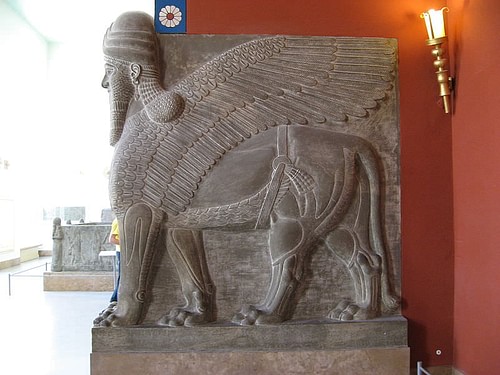
LUGALBANDA - The third king of the city of Uruk, husband of the goddess Ninsun and the father of Gilgamesh. He is featured as a legendary hero in some stories.
MAGILUM BOAT - Also known as `The Boat of the West', the Magilum Boat carried the souls of the dead to the underworld, sinking into the west over the horizon. Famously mentioned in The Epic of Gilgamesh: "All living creatures born of the flesh shall sit at last in the boat of the West, and when it sinks, when the boat of Magilum sinks, they are gone."
MAMMETUM - Also known as Mamitu, the Akkadian goddess of fate and destiny. According to some myths, she dwelt in the underworld and simply made up the fates of humans on a whim; but whatever fate she decreed would come to pass.
MARDUK - The Babylonian King of the Gods, the hero-god who defeated Tiamat and the forces of chaos and brought order to the universe which the gods and humans work together to maintain. He is the god of healing, justice, compassion, regeneration, magic and fairness. He was known as the peacekeeper among the gods and was referred to, in this regard, as `Shepherd of the Gods'. In the Epic of Irra, Marduk leaves the city of Babylon in the hands of Nergal (Irra, Erra) who destroys it in a rage. Marduk was one of the most popular and enduring gods of Mesopotamia and was adopted by the Assyrians as son of their supreme god Assur.
MISHARU - The Sumerian god of law and justice, brother of Kittu. See KITTU.
MUMMU - The Babylonian god of craftsmen. The god Ea is known as Ea Mummu in his role as the creator of human beings and the word `mummu' is understood as `genius' as in `knowing how to craft'.
MUSHDAMMA - The Sumerian god of foundations and buildings, brother of Kabta (god of pickaxes, construction and bricks) and one of the sons of Ninhursag.
MUSHHUSHSHU - The Babylonian protective spirit, featured prominently on the Ishtar Gate of Babylon, whose name translates as `furious snake'. The Mushhushshu was a creature shaped like a slender dog with a scaly body and tail, bird's talons, a long neck, forked tongue and a protruding horn. The god who controlled the Mushhushshu was considered the supreme god and so many early gods were associated with this creature until, finally, it became linked with Marduk.
MYLITTA - The Assyrian goddess of fertility and childbirth.
NABU - The Babylonian god of writing and wisdom, son of Marduk and grandson of the god of wisdom, Enki (Ea). His name means "The Announcer" in reference to his prophetic abilities and the gift of writing. He was the patron god of scribes and safeguarded The Tablets of Destiny which legitimized the ruler of the universe (alternately given as Anu, Enlil or Marduk and, later, Assur)). He is depicted holding a stylus and either riding on or standing beside a Mushhushshu dragon. Nabu was one of the most important gods of Mesopotamia and, without him, the great Babylonian Akitu Festival held to honor the gods and give thanks for the harvest could not be celebrated. He was venerated for thousands of years and among the few to survive the fall of the Assyrian Empire in 612 BCE when the statues and temples of many gods were sacked by invading forces. He is often compared with Thoth of the Egyptians, Apollo by the Greeks, and Mercury by the Romans.
NAMMU - The Sumerian goddess of the primeval sea and the early abyss, a mother goddess. There is also a Babylonian goddess of the same name who is associated with fresh water but is a more minor deity.
NAMTAR - The Sumerian demon-god of fate concerning death, also known as the Herald of Death, associated with Ereshkigal. He carries messages from the underworld to the upper realms of the gods. He was famously insulted by Nergal at the banquet thrown by the gods where he represented Ereshkigal because she could not attend. This insult results in Nergal eventually falling in love with Ereshkigal and living with her in the underworld.
NANA - A virgin mother goddess whose attributes were assumed by Inanna.
NANAJA - A Sumerian goddess of sex and war whose attributes were assumed by Inanna.
NANNA- (also known as Nanna-Suen, Nannar, Sin) - The Sumerian god of the full moon and wisdom, father of Inanna in some stories and father, with Ningal, of Utu/Shamash, the sun god. Son of Enlil and Ninlil, considered an important deity in the act of creation. His symbol is the crescent moon and he was associated with the power of the bull and lion-dragon. Best known through the work of the poet/priestess Enheduanna. Nanna is one of the oldest gods in the Mesopotamian Pantheon and is first mentioned at the dawn of writing in Sumer c. 3500 BCE.
NANIBGAL - A minor goddess, consort of Ennugi, god of dikes and canals. She is frequently associated with the goddess Nisaba (Nidaba) in her capacity as keeper of accounts/records.
NANSHE - (also Nanse) -The Sumerian goddess of social justice who looked after orphans and widows. She also oversaw fairness, fresh water, birds and fish, fertility and favored prophets, giving them the ability to interpret dreams. She was also known as the Lady of the Storerooms and, in this capacity, oversaw that weights and measures were correct. Her consort was Haia, god of storerooms. She was adept at interpreting dreams and, in one famous myth, the pious king Gudea consults her regarding a dream about the proper time to build a temple.
NEDU - The Babylonian guardian of the gates of the underworld.
NERGAL - Also known as Erra/Irra, the Sumerian god of war, pestilence, destruction, death, and the underworld, co-ruler with Ereshkigal, but originally associated with Shamash, the sun god, and a solar deity. His cult center was at Kutha where he was first known as Meslamtaea, an agricultural god associated with the heat of the sun in its negative aspects. The intensity of the summer sun (or the sun at midday) was thought to be caused by Meslamtaea's fury and shifted from a regional god to a universal god associated with the negative aspects of life. Nergal is best known for insulting Namtar, Ereshkigal's representative at the feast of the gods, and having to make amends to her, resulting in their love affair and his eventual move to the underworld to live with her. In some myths he is credited with creating human beings and in incantations is invoked for protection because of his great strength. As Erra he is famous from the work The Wrath of Erra in which he destroys Babylon for no reason.
NETI - The Sumerian guardian of the gates of the underworld and scribe. Neti features prominently in The Descent of Inanna.
NIDABA - The Sumerian goddess of writing and astrology.
NIN-AGAL - The Babylonian god of the forge and patron god of smiths.
NINAZU - Babylonian healing god, son of Gula, associated with serpents (symbols of transformation) and the underworld (transition). He held a staff of intwined serpents which was borrowed by both the Egyptians and the Greeks and is recognized today as the caduceus, symbol of Hippocrates, father of medicine.
NINGAL - A Sumerian goddess of fertility associated with the sun, mother of Utu/Shamash, the sun itself, and wife/consort of Nanna, the moon-god. Her name means `Great Lady'.
NINGISHZIDA - A Sumerian god of the underworld alternately the son of Ereshkigal and Gugullana or of Anu, the sky god. His symbol was the serpent Basmu entwined around a staff much like the later Caduceus of Hermes. He was known as the `Lord of the Good Tree' and was associated with protection and fertility. Also known as Geshida and, under that name, appears with Tammuz as a dying and reviving god figure who watches the gates of the gods in the Myth of Adapa. SEE GISHIDA.
NINGIZZIA - The Babylonian guardian of the gates of heaven who watches over the eastern gate, the most prominent, as it is the gate of the morning.
NINHURSAG - The Sumerian Mother Goddess, goddess of fertility, nature and life on earth. Her name translates as `Lady of the Mountain Side' and she was known as the `Mother of the Gods'. She originally was a very popular goddess whose attributes were later taken on by other deities. She is also known as Belet-Ili, Damgalnunna, Ki, Nintu, Nintur, Aruru, Ninmah, Mami and Mama. Ninhursag features in many of the most popular Mesopotamian myths where she is always associated with life, fertility, growth, and transformation. Her primary duty was care for women and children, especially pregnant women and young children. She watched over a child from conception, through gestation, and after birth provided the child with food. As with all of the female deities in Mesopotamia, Ninhursag suffered a loss in status during the reign of Hammurabi of Babylon (1792-1750 BCE) and was eventually replaced as a supreme power by male gods.
NIN-ILDU - The Babylonian god of carpentry and patron of carpenters.
NINKASI - The Sumerian goddess of alcohol, beer and brewing, patron of brewers. She was said to brew a fresh batch of beer every day from the finest ingredients. One of the most famous works concerning her is the Hymn to Ninkasi from the 19th century BCE which is both an homage to the goddess and a recipe for brewing beer. Also known as Ninkar.
NINLIL - The Sumerian goddess of air, `The Lady of the Air', whose name was originally Sud until she married Enlil. In one version of the story, Enlil seduces Ninlil and is banished to the underworld. Ninlil follows him there and gives birth to the gods Nanna, of the moon; Nergal, of war and death; Ninazu, of the underworld, healing and magic incantations; and Enbilulu, of rivers and canals. These gods then rise from the underworld to earth and sky in keeping with the motif of the fertility myth of the dying and reviving god. The Babylonian goddess of the same name is derived from this Sumerian deity, originally introduced by the Akkadians.
NINSHAR - The Sumerian goddess of birth and stony ground who, with her brother Enshar, encircle the earth to create the horizon.
NINSHUBUR - The Sumerian goddess of the east who was friend, confidant, defender, advisor and traveling companion to Inanna. Ninshubur plays a prominent role in many of the stories concerning Inanna. In the poem Inanna and the God of Wisdom she protects Inanna and the sacred meh and in The Descent of Inanna she is the faithful friend who finds help to free Inanna from the underworld. A minor Akkadian god of the same name (though often given as Ninsubur) appears in some myths as minister to the god Anu. This male deity eventually replaces the earlier goddess in the Neo-Assyrian and Neo-Babylonian periods and assumes the role of guardian.
NINSUBUR - (also Il-abrat) - Minister to the god Anu, assimilated eventually into Papsukkel, minister to the general assembly of the gods.
NINSUN - The Sumerian Mother Goddess best known as the mother of Gilgamesh. She was adept at interpreting dreams and was very wise. Her name is translated as `Cow of The Wild Enclosure' or, alternately, `Great Lady'.
NINURTA - The Sumerian god of war and the south wind, raucous son of Enlil and Ninhursag, best known for retrieving The Tablets of Destiny for Enki after they had been stolen by Anzu. Ninurta was depicted as a fierce god who more often used his brawn instead of his brains. In an early myth, his mother tries to kill him by hurling rocks at him. When the rocks fail to harm Ninurta in the least, Ninhursag takes the life force from them and they become dead stones. Those rocks who refused Ninursag's task to be thrown as weapons, Ninurta rewarded by transforming them into precious gems. The Babylonian god of the same name is derived from this Sumerian deity. He is usually depicted as an archer either standing or running on the back of a monster with the body of a lion and the tail of a scorpion.
NIRAH - The Sumerian snake god, god of snakes.
NISABA - (also Nissaba, Nidaba, and associated with Nanibgal) - Originally the Sumerian goddess of grains, cereal and grasses, most notably the sturdy reeds which grew in the canals and which scribes would use in writing. Consequently, Nisaba became the patron goddess of writing, scribes and, particularly, accounting. She grew in stature to become the goddess of writing and scribe of the gods. At this point she was also recognized as the mother of Ninlil (Sud) who was the wife of Enlil, supreme god of the sky. Schools were established in her name in Sumeria by 2000 BCE and she was widely praised in hymns and inscriptions. She lost status during the reign of Hammurabi of Babylon (1792-1750 BCE) when she was replaced by Nabu as god of writing. Afterwards she is sometimes depicted as Nabu's wife.
NUSKU - The Babylonian god of fire, both heavenly and terrestrial, patron god of civilization which would not have thrived without fire.
PAPSUKKEL - (also Papsukkal) - The Sumerian minister of the gods. Associated with the Akkadian god Ninsubur, minister to Anu, King of the Gods. Represented as a robed, bearded man wearing a horned cap and holding a staff.
PAZUZU - The Sumerian demon who was charged with protecting human beings from plague and the forces of evil. He was especially invoked for protection of pregnant women and infants against the schemes of the evil demoness Lamashtu. Though a force for good, he was also the personification of the south wind and the south-east wind which brought pestilence and disease.
QUEEN OF THE NIGHT - A terracotta relief (known as the Burney Relief) from c. 1792-1750 BCE depicting a Babylonian goddess whose identity is not clearly established. She has been identified as both Ishtar/Inanna or as Ereshkigal as well as with the demoness Liltu/Lillith. She is depicted as a naked woman with wings, holding the rod and rings of power, standing on two lions and flanked by owls. As the wings point downward, there is an association with the underworld and Ereshkigal established but no stories link that goddess with owls. The figure of a woman standing or riding on a lion is associated with Inanna/Ishtar, as would be the ring and rod of power, but there is no mention of wings on this goddess and no owl connection. Liltu, who caused pregnant women distress and made women barren or, at least, made it difficult for them to conceive, was closely associated with owls but not with wings, lions nor the rod and rings of power. The identity of the Queen of the Night, therefore, remains unknown.
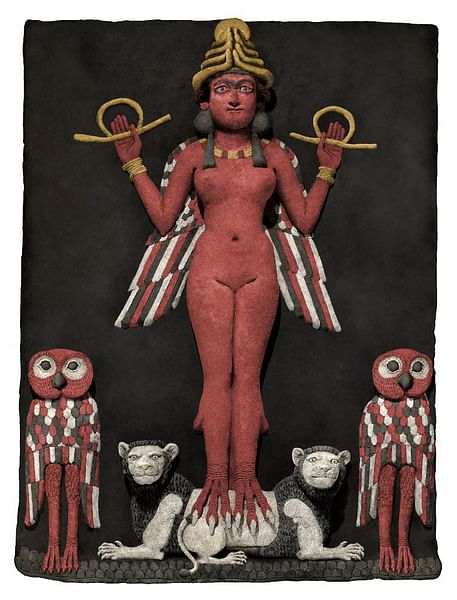
QUINGU - Also known as Kingu, the consort of Tiamat and her champion in her war with the younger gods. He stole the Tablets of Destiny for use as a breast plate in battle. After his death in battle, his blood and flesh were used in the creation of human beings.
RAMMAN - The Akkadian and Sumerian storm god associated with both Adad and Nintur, mentioned in The Epic of Gilgamesh. Also known as Rimmon.
SAKKAN - The Sumerian god of cattle charged with protecting both domesticated and wild animals. He was responsible for the fertility of animals in the wild and was often depicted as a shepherd. In Akkadian he was known as Sumuqan. In both The Epic of Gilgamesh and the Sumerian poem, The Death of Gilgamesh, Sakkan/Sumuqan is mentioned in connection to the underworld.
SCORPION PEOPLE - In Sumerian and Babylonian stories, the Scorpion People were powerful servants of the sun god Utu (Shamash). They had a human head, arms and torso but were bird-like below the waist (sometimes with human legs, sometimes bird) and a scorpion's tail. The people of Mesopotamia invoked the Scorpion People as figures of powerful protection against evil and the forces of chaos. In The Epic of Gilgamesh the Scorpion couple, Scorpion Man and Scorpion Woman, guard the great Gate of the Mountain where the sun rises and are described as `terrifying'.
SEBITTI - According to Babylonian sources, the Sebitti were seven minor warrior gods, sometimes associated with the Anunnaki of the underworld, who followed the demon Irra into battle. The Sebitti were not comprised of any of the major gods but seem to have been associated with Nergal. They are also associated with the Pleiades.
SHAMASH - (Also known as Samas, Babbar, Utu) - The Akkadian god of the sun who is identified with the earlier Sumerian sun god Utu. Shamash was god of supreme justice and was often invoked for the protection of travelers, merchants, soldiers and sailors. He is often depicted holding a blade with which he cuts his way through the mountains each morning at dawn. In his duties as protector he is also envisaged in a boat (for sailors) a chariot (for soldiers) or on horseback (for travelers and merchants). His consort was Aya (also Aja, and Serida or Sherida in Sumerian), goddess of dawn.
SHARA - A minor god of war in Babylonian mythology, son of Anu and Ishtar.
SHERIDA - (also Serida) -The ancient Sumerian mother goddess, giver and sustainer of light and life. One of the oldest gods in Mesopotamia, she was once a primary deity who, in time, assumed a subordinate role as consort to the sun god, Utu. She was known, in this capacity, to the Akkadians and Babylonians as Aja (or Aya) the goddess of dawn.
SHULPAE - The Mesopotamian god of feasts and good times, sometimes represented as consort of Ninhursag.
SHUTU - The Sumerian god of sickness, personification of the south wind.
SIDURI - The alewife in The Epic of Gilgamesh who advises the hero to abandon his quest for immortality and simply enjoy life. She is thought to symbolize the distractions in life from higher matters. Gilgamesh ignores her advice and she directs him on the path to Utnapishtim.
SILILI - The Babylonian goddess of horses, known as `The Divine Mare', the mother of all horses.
SIN - (Nanna, Suen, Nanna-Suen, Nannar) -The Babylonian god of the moon whom the Sumerians knew as Nanna. Sin was associated with the fertility of women and cattle. His name is pronounced `seen'. He is depicted as a man standing with a crescent moon.
SUMUQAN - The Akkadian and Babylonian version of Sakkan.
SUMUGAN - The Sumerian god of the open plains. Also known as Shumugan, he was responsible not only for the plains but the animals who grazed upon them.
TABLETS OF DESTINY - The sacred objects which legitimized the rule of the supreme god and conferred upon their holder the power to determine the destiny of the world. They were stolen from Enlil by the Anzu bird, who was supposed to guard them, and retrieved by Ninurta. In the Enuma Elish they are given to Quingu by Tiamat and taken from him, after his death, by Marduk.
TAMMUZ - The Babylonian version of the Sumerian Dumuzi, a vegetation, dying and reviving god figure. Along with Gishida, also a dying and reviving god figure, he guards the gates of the gods in the Myth of Adapa.
TIAMAT - The primeval Mother Goddess of Mesopotamia, mother to the gods, consort of Apsu, appearing in the shape of a dragon. She was defeated in battle and killed by Marduk. After her death, the Tigris and Euphrates rivers flow from her eyes. Her story is told in the Babylonian creation myth the Enuma Elish. Tiamat was envisaged as salt water and Apsu as fresh water; from their union came all the other gods.
TIAMAT'S CREATURES - Eleven terrifying monsters created by Tiamat to avenge the death of Apsu and destroy the younger gods. There were three fearsome horned snakes: Musmahhu, Usumgallu and Basmu; the snake-dragon Mushhushshu; Lahmu the hairy super man; Ugallu, the lion-demon; Uridimmu, the lion-man; Girtablullu, the scorpion-man; Umu-Debrutu, terrifying storms; Kulullu, the fish-man (mermen and mermaids) and Kusarikku, the bull-man. All eleven of Tiamat's creatures were defeated by Marduk who preserved images of them in the watery remains of Abzu to commemorate his victory. They were made ample use of by the people of Mesopotamia in magical incantations and to ward off evil and the forces of chaos. Many of their images are well known today through statues outside of palaces and temples, most notably the Ishtar Gate of Babylon.
UMMANU - Throughout Mesopotamia, the Ummanu were the great scribes who wrote the epic poems (among them, the Enuma Elish, Myth of Etana, The Epic of Gilgamesh). They were also considered expert astrologers. The Ummanu refers not only to the scribes but also to what they wrote. The Chief Scribe of a king (such as Sargon of Akkad or Assurbanipal) was charged with recording his monarch's glorious achievements and, by 640 BCE, the written ummanu were considered important enough to include in the King's Lists.
UMUNMUTAMKAG - The Babylonian god of offerings who was the intermediary between human beings and the gods. He presented the sacrificial offerings to the gods in a pleasing fashion.
URSHANABI - The boatman in The Epic of Gilgamesh who ferries Gilgamesh across the waters of death to the land of Dilmun (paradise) where the immortal Utnapishtim lives. Urshanabi breaks the eternal laws governing his position as ferryman by taking Gilgamesh to Dilmun and travels back with him to the city of Uruk at the end of the epic.
USMU - The Akkadian messenger god of Ea (known to the Sumerians as Enki). He was a two-faced god (representing his coming and going on errands) depicted as a man presenting a bird-man before Ea.
UTNAPISHTIM - In The Epic of Gilgamesh, the wise and pious man who is warned by the god Ea of the impending flood and, with his wife and the `seed of life' builds an ark and survives the deluge. After the Great Flood he and his wife are granted immortality and live in The Faraway `at the mouth of the rivers' (Utnapishtim himself is referred to as `the faraway, also). He was also known as Ziusudra to the Sumerians and first appears in The Epic of Atrahasis under that name. `Utnapishtim' is translated as "He Who Saw Life" as he was the only man to survive the Great Flood. Many similarities between the much older Mesopotamian flood story and the Biblical tale of Noah in Genesis have been noted.
UTTU - The Sumerian spider goddess. She was the patroness of weavers, weaving and clothing, daughter of Enki and Ninkurra. She is best known for her role in the myth Enki and Ninhursag in which she complains to the mother goddess about Enki's neglect and is told to wipe his seed from her body, thus fertilizing the earth and giving birth to the first plants and trees.
UTU - (also known as Shamash, Samas, Babbar) - The Sumerian god of the sun and justice, one of the oldest deities in the Mesopotamian Pantheon, dating from c. 3500 BCE. See SHAMASH.
WE-LLU - Another name for Geshtu, the god who sacrifices himself to create humanity.
ZABABA - The Akkadian god of war. He was one of the many consorts of Inanna/Ishtar.
ZAKAR - The Babylonian god of dreams. Dreams were considered messages from the gods. Zakar's responsibility was to send these messages to the appropriate human recipients. He was known to the Sumerians as Zaqar.
ZARPANIT - The early Sumerian and Babylonian goddess of fertility, charged with the fertility of the whole universe. Also known as Beltia, her attributes were later assumed by Inanna and then Ishtar. She was sometimes the consort of Marduk.
ZALTU - The Babylonian goddess of strife. She is associated with Ishtar and personifies the destructive side of the goddess.
ZU - The Akkadian version of Anzu/Imdugud, the storm bird who steals The Tablets of Destiny from Enlil.
